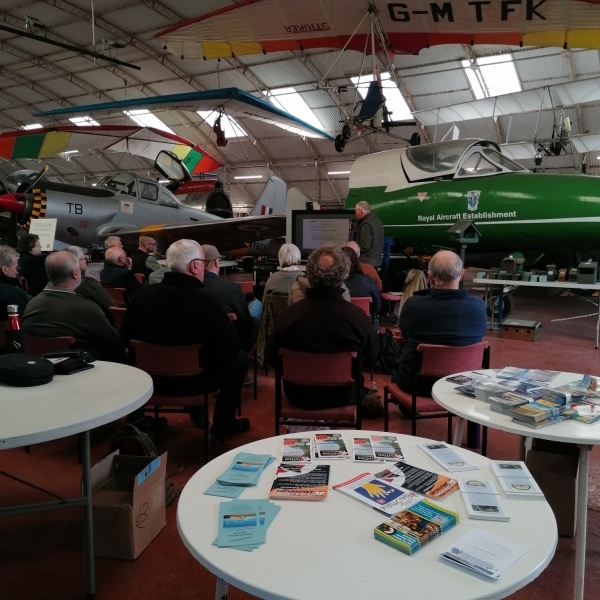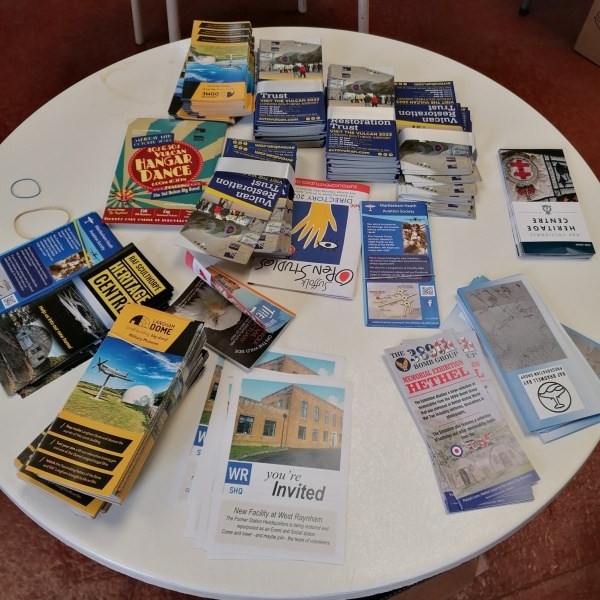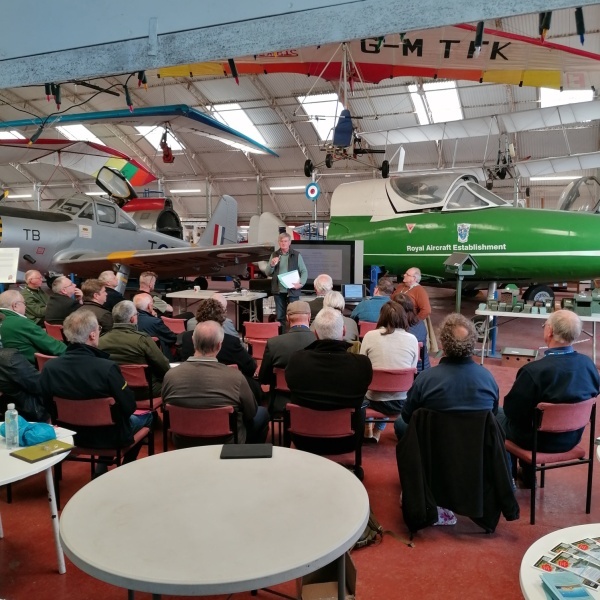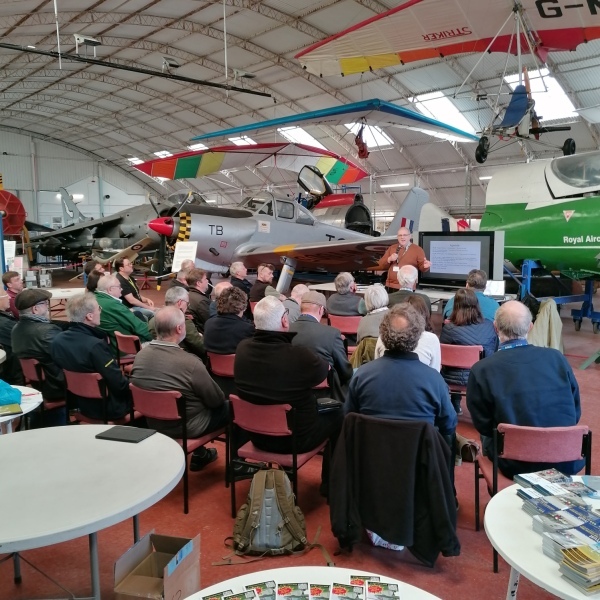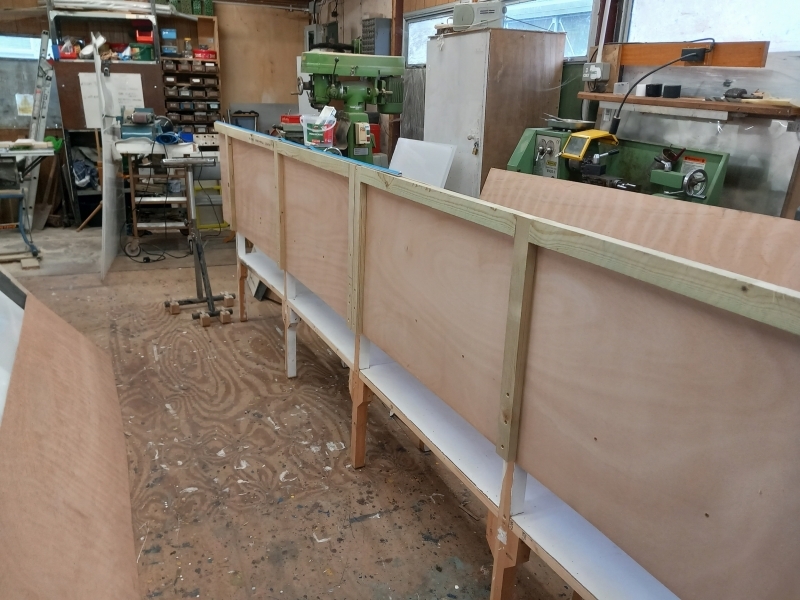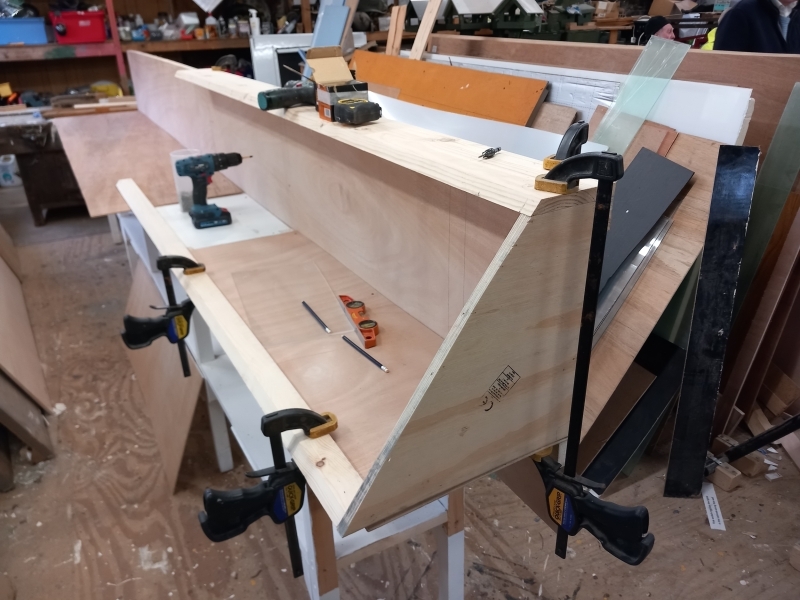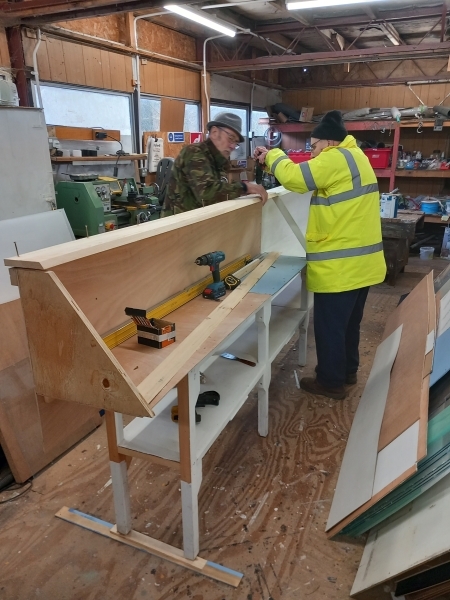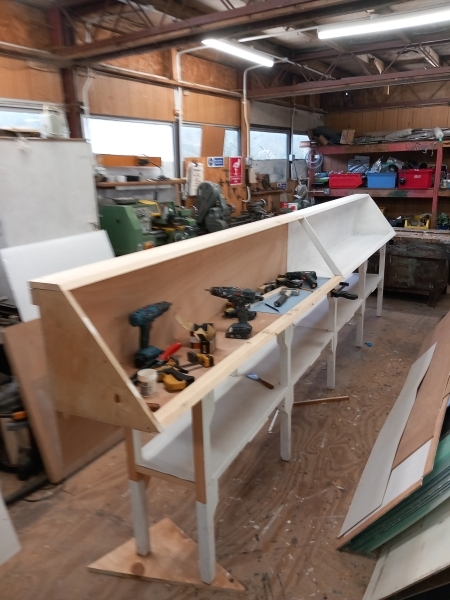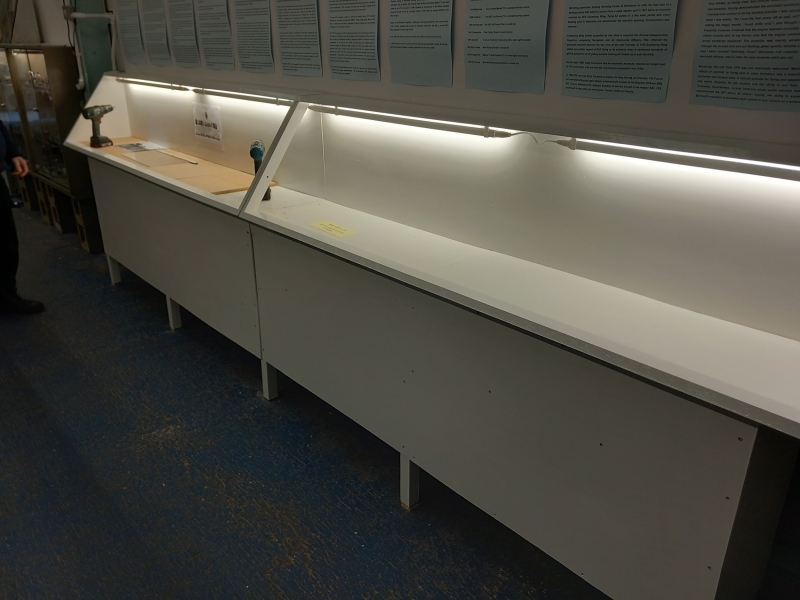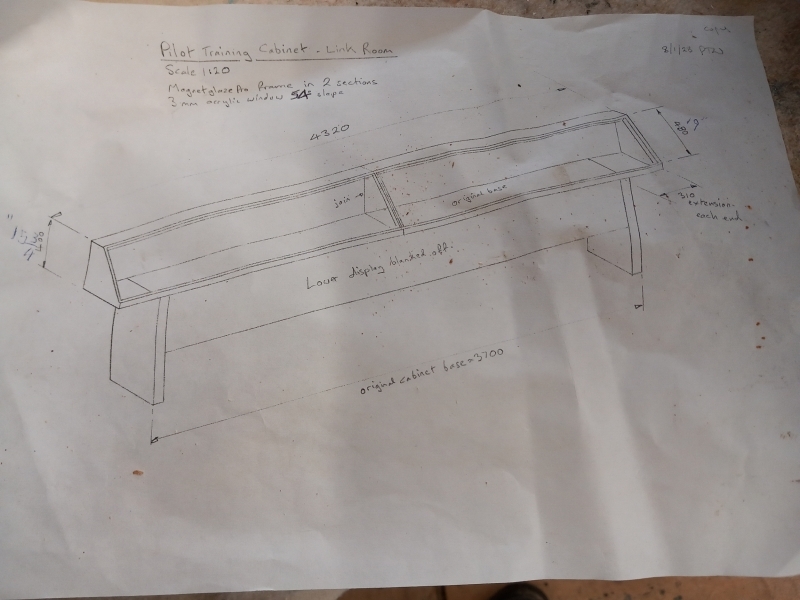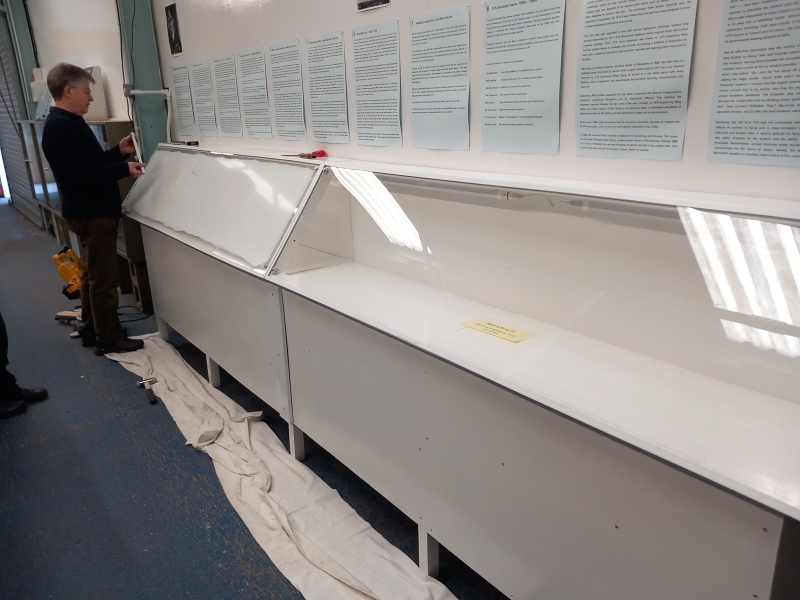NASAM Update as of the 5th May 2023
[joli-toc]
In This Edition – Notes
From the Museum Manager
We start this edition with some photos from Gary of a special conference at the Museum. This is one of a number of private events that have happened in 2023 so far, with more still to come. Some of these events are during public open days and some are arranged outside the normal opening dates.
If you would like to make a special booking for a private event at the Museum, you can find out about visits and then if you wish you can start that conversation by clicking on the button below and then by filling out and sending the form through to us.
Also from Gary, I had a note with a photo which said “Please see the attached photo showing some unexpected visitors that had a look around our museum on Saturday 29th April. The visitors in question were from Norfolk Steam Punk on an outing“. I thought, like Gary, it was worth posting in the blog as we don’t very often get such colourful visitors here. The photo is below.
From the Teams
We have updates from Archives in which Graham draws our attention to a Home Guard Training Manual of 1941. Then a large update from Michael in which he explains the pains of trying to get a new style cabinet into the hangars and so keep artefacts and exhibits dust and condensation free.
NOTE: As an addendum to the Archive Home Guard Manual article, I was copied on an email exchange between Michael, who is a regular contributor to the blog in the Chippies Team, and Graham from Archives in response. I have summarised those emails after the article for interest, as it all adds a little bit more information to the document in archives and how it got there.
This Coming Sunday at the Museum
The next event at the Museum will be this coming Sunday the 7th of May 2023. This event will be a 40s Themed Day at the Museum.
There will be people in 40’s period costumes – mostly military uniforms but also civilian clothing too.
Mike Kendal and his 40’s dancers will be providing wartime music, dance and entertainment in the main hangar and everyone is encouraged to wear something appropriate to those wartime years!
We have been told that the Suffolk Triumph Owners Motorcycle Club will be organising a RIDE-OUT to the Museum for all their 150 members. We don’t expect 150 Triumph motorbikes to visit us – but believe that about 10 to 15 examples of their modern, vintage and veteran British machines will be joining us for the day. If the weather holds fine – there may well be more! We intend to gather them around the Hunter near the hangar doors so there should be some great photo opportunities as well as the chance to chat to Club members during the day. They may possibly be persuaded to start a few to add to the 40’s soundtrack from the main hangar.
Check out the club website at https://www.stomcc.co.uk for more details about the club – and to see events that they have arranged for themselves later in 2023.
Pete S

From The Teams
From the Museum Manager
Military Aviation Heritage Network Conference
Please see the attached photos below of the Military Aviation Heritage Network (MAHN) conference. This took place at the museum on Thursday, the 27th of April 2023. The Military Aviation Heritage Networks are groups of organisations that bring together those who care about aviation heritage, its conservation, commemoration, display and sustainability. The networks are regionally based, and details are on their website @ https://www.mahn.org.uk/
Please note our very own Cliff Fowler talking about the Stirling Project to the delegates.
A very satisfactory day all around, with very happy delegates, monies taken in the NAAFI care of yours truly, and some donations to boot.
Gary
(Photos) MAHN Conference
Steam Punk Visit
Please see the photo below showing some unexpected visitors that had a look around our Museum on Saturday 29th April. The visitors in question were from Norfolk Steam Punk on an outing.
On the following Wednesday I received an email from the group as follows:
Dear team,
I just wanted to send a quick thank you for your brilliant hospitality on Saturday from all of us at Norfolk Steampunk. We were the gang in goggles and moustaches.
We all had such a lovely time and are looking forward to organising another visit soon
Best wishes
Sam
on behalf of the Norfolk Steampunk Committee
Gary
(Photo) Norfolk Steam Punkers Visit
Click to expand
![]()
From the Archives
Hedges
Today’s lesson in defensive warfare is taken from a handy booklet discovered in the deep shelves of the NASAM archives. Our edition dates from July of 1941 and is called simply “The Home Guard Training Manual” – it’s a very recent addition to the store of books we hold, but is set to become a favourite!
It’s comforting to think that the guidance contained between its covers fuelled the like of Capt Mainwaring and his Walmington On Sea force.
Taken from Section III, ‘Understanding Your Countryside’, our gallant troops are offered the following instructions regarding walls and hedges…
How to Examine Local Hedges.
You should examine all hedges, fences, field partitions, etc., in your neighbourhood, and ask yourself the following questions:
 (a) Does this hedge give me cover from view from the enemy?
(a) Does this hedge give me cover from view from the enemy?
(b) Does it give me cover from fire?
(c) Can I approach it unseen?
(d) Can I approach it from one or other end?
(e) Can I get through it quickly?
(f) Can the enemy trap me?
(g) What advantages will it give to the enemy:
(i) If he does not know of my presence?
(ii) If he knows of my presence?
Always be careful to consider each hedge from both sides and directions. Do not make the mistake of imagining that you will be on the favourable side from your point of view, and the enemy on the other.
Don’t forget the effect of seasons on hedges: good cover from view in summer may be bad cover from view in winter. Don’t forget that a hedge, which is so thin that you can see through it when you are close behind it, may be perfectly good cover from view from an enemy looking at it a mile away.
Walls
There are, of course, parts of England where walls take the place of hedges and ditches. The ordinary wall is not likely to be strong enough to hold up even the lightest tank, and its value is solely as cover.
Exercises and observations suggested for hedges hold good for walls.
Walls exist in parts of the country where stone is common; therefore there will usually be plenty of material lying around to strengthen vital places.
In some parts of Britain (e.g. the Fenlands) fields are bounded by deep ditches full of water and there are drainage channels at frequent intervals. These are admirable obstacles especially if strengthened with barbed wire.
You should seek opportunities of enfilading the enemy from cover at such points.
How could we ever go wrong with this kind of guidance!
Graham
How did the pamphlet finish up in the Archives
Email exchange:
From Michael F:
…….. If I could, add an addendum to the article about the Home Guard Training Manual.
It was recently donated to the Museum by me from the things I inherited from my father, Pierre F. It was a souvenir of his time in the Home Guard before joining the Fleet Air Arm where he rose to the dizzy rank of Temporary Acting Leading Air Mechanic. His final posting was to a MONAB being formed at St Merryn for deployment to the Pacific but fortunately for him, the war ended before they were actually deployed. As we spent hours as children poring over his books, particularly this one, I would say he is where I gained my abiding passion for all things military, naval, aviation and engineering. …… Michael F
____________________
From Graham:
…….. I’m glad I found your father’s book on the shelf in the main archive building – I spent a happy half hour leafing through it on Tuesday and I think it may feature again at some point as a blog article as a window to a world that most of us have never seen.
………….. – to be able to add to the provenance of any item in the museum is a rare thing. If you’re happy that I do so, I will record your notes here into the inventory entry for the book so that, in years to come, we will know more of its history and ownership. Having an item in the museum is one thing – having a personal history for that item is entirely another. I hope that’s ok.
Best wishes – and thank you for the notes. ……… Graham
Chippies Update
Another “Winter” Project from the Chippies has drawn to a close. Yes, it’s early, even mid, Spring now and this one has dragged on a while but is off the books now, or at least as far as the Chippies are concerned.
Back in October or whenever, this Project wasn’t on our list of work. Sometime around January Peter W asked if we could work on a new design for display cabinets he had in mind. While we beavered away at the rest of the projects, Peter was experimenting and drawing and modelling away. His plan was to convert the cabinet along the outer wall of the Link Trainer Room into a new-style cabinet.
Unfortunately, like in all the buildings at the Museum, it was subject to condensation forming on the flat top, which was perspex, to which dust got added and so demanded regularly careful cleaning so visitors could see inside. Due to the design, it let in the dust, which meant every year the artefacts inside needed cleaning. Many displays in the Museum are like this and require hours of Volunteer time to make them pristine for viewing. Peter wanted to try something new.
He designed a cabinet with a sloping front which should achieve two things: any condensation would drip onto the floor, and would not reflect the ceiling lighting, which made viewing hard. He then wanted to use edging for the perspex which used a magnetic join to seal the cabinet, stopping the dust from getting it. To save money he wanted to reuse the existing cabinet, cut down with a new display to his specification. Easy!
Of course, come February when the Chippies finally got round to looking at his plans and mock-up, after careful consideration of course, went: “Nah! Don’t do it like that!” Well, in principle yes we could build it but not exactly how Peter originally, or even subsequently, envisaged it. After much debate and gallons of tea, we hatched a plan and a modified design which everyone was happy with. Removing a couple of what we thought were fancy extras, we could simplify its manufacture. Now everyone had agreed on what to make, it was time to fetch the cabinet into the workshop.
First we needed some space: that cabinet was already 12 feet long (about 3.6 metres) and it needed to grow to 14 feet (4.2 metres) and the workshop at the time was crowded. Fortunately, our friends in the Paint Team were looking for work, so we moved the tables for the Luftwaffe Weg into the Engineering Workshop where they (the Painters) could stay warm.
Next Ash and Michael F paid a visit to the Link Trainer Room to work out how to move the cabinet. Dave H built it originally and claimed it was in two halves and was easily transported just by undoing a few screws. Ah no! It was two sections but not easily halved because Dave had assembled it in the room and, without completely destroying it, downright difficult to disassemble. So we retired to the Workshop for tea, no sympathy and drum up an idea of how to shift it. The answer was it would have to come out in one piece.
Those who know the Link Trainer Room and its layout will appreciate the difficulty of manoeuvring a 12-foot-long lump of wood, getting it out through any of the doors let alone the side door (the other options were worse!) and forgive your heroes if their language was less than gentlemanly. Once outside, getting it over to the Workshop was easy, if a little precarious, as it balanced on top of a trolley. So far so good.
The next part was easy, and right up Dave’s destructive street. Off came what remained of the top display (Peter had already removed some) then the back and side panels. These we recycled to box in the lower half later. Finally, out came the multitool to neatly trim off the uprights at the top shelf level and we had a base to start building upon.
Next up, new plywood was screwed to the back of the cabinet for the back wall of the display area. Another of Peter’s stipulations was that the interior was to be as clean and flat as possible with no structural members showing. So the stiffening members went on the back behind the plywood. We added bracing on the front of the ply on the new extended “wings” to support them. OK another step forward, time to think about the next bit. Which of course involved tea!
To be fair to Peter, many of the cabinets we have built have been “robust” with 2-inch (50mm) square timbers for structural support and they do look chunky. But when other Volunteers are putting some seriously heavy kit on them, well…
But this case is for model aircraft dioramas so heavy-duty is not necessary and we already had a robust base. So the specification was as narrow as possible but the front had to be able to take the magnetic strip for the edging.
We settled on 3/4 inch (18mm) ply for the end wall and 3/4 inch planks for the top and bottom support. We cut an 8-inch (200mm) plank at the required 53° angle using the magic of the table saw (and the clue is to put the blade at 37°): the wider section would be the top and the narrow bit the bottom support. Yes, we’d done our own experimenting beforehand to get the sizes needed, we don’t just drink tea when thinking. To get everything to fit we put in a new base which overhung the front of the original and get the required depth.
So now we had one half built and time to do the other. This is where we ran into the idiosyncrasies of the original cabinet. To get everything screwed in, we ended up having to unscrew the two halves, which actually meant undoing some of the new work. Joy of joys, but hey you do what you have to.
With it in two halves, work on the second half was easier and allowed Les to wield his trusty paintbrush and a tin of undercoat on the completed half. Now the astute amongst you will say “you need to make sure they all line up”. Well, that’s what we did: we kept lining them up and pulling them apart as needed. And making sure they joined together level and the joins were smooth. Eventually, by the end of February the two halves were ready for their visit to the Engineering Workshop for the Painters to do their bit (they were still claiming it was cold outside).
Mid-march came and they were ready for Peter to take away. This bit gets vague, Michael was en vacance and this is hearsay, so probably totally untrue. The two halves went to the Link Trainer Room accompanied by people who were not Chippies who could not get them lined up and joined together. Ash was called it “to chop bits off” but the two halves stubbornly refused to join properly. What was needed was “trained” Chippies armed with brute force, guile and quarts of tea.
So it was on Michael’s return, he and Ash returned to the scene of the crime. With the use of drilldrivers, a few wedges (that floor isn’t level), careful rearrangement of the cabinets brought them together in and – almost – perfect fit. Guile and tea are the answer, plus knowing how they fitted together in the first place.
Only one job left to do – fit the perspex panels. These were ready and waiting in the workshop so one Tuesday morning, Peter Ash and Michael started the task. And it really turned out to be a three-hand job, but as a team we got the right-hand front fitted. Though the magnetic strip holds the panel, there was some slippage, so for safety, Peter added some screws in each corner. Here the thin construction was a disadvantage because he could not screw into the wood as the edging was in the way. So he manufactured some brackets which he mount on the wood and then bolted through the perspex to lock the fronts in place.
A couple of weeks later, towards the end of April, Peter and Michael started putting the left-hand panel on. They soon summoned reinforcements (Ash) as the unwieldiness of the 7-foot panel and the care required once again showed many hands make light work. And so finally the new style display cabinet, as far as the Chippies were concerned, was complete and time to celebrate with cups of well-deserved tea.
Was it all worthwhile, this new-fangled approach? Well in appearance: yes. Will it do what it is supposed to keeping out dust and draining the condensation? Time will tell. We await the public and Committee responses but already a certain Chairman was heard muttering that he’d like to see the thinner structural members in future. Sounds like in the Chippies Workshop we’re going to have to teach one of our crew new tricks. I wonder which one that is?
Michael
(Photos) Chippies Update
The Repeat Info
The repeat information is still here I’m afraid, and I make no apologies for keeping his section in our blog. We are a charitable organisation relying on monies from the public to keep us going. Any help we receive is gratefully accepted and enables the museum to continue in our mission “To conserve, preserve and promote the history of aviation in East Anglia, whilst providing a fun, family-friendly and interactive museum, promoting education and remembrance of the events of the past“.
Are you thinking of helping ??
 We obtain most of our finances by donations and by membership fees. We save money by having a dedicated group of volunteers that keep the museum and the exhibits both manned and maintained. We hope therefore a few people may consider helping in the ways below.
We obtain most of our finances by donations and by membership fees. We save money by having a dedicated group of volunteers that keep the museum and the exhibits both manned and maintained. We hope therefore a few people may consider helping in the ways below.
There are three easy ways to help: Help by becoming a Museum Member, also by Volunteering to help at the museum, or by Donating to assist in our running costs. Please click on the appropriate button below to access the appropriate information:
Keep Up To Date
![]() To keep up to date with further information, please keep an eye on our Social Media (see the Social Media buttons at the foot of this blog) or click on the button below to be notified by email of any upcoming changes by seeing the latest blog.
To keep up to date with further information, please keep an eye on our Social Media (see the Social Media buttons at the foot of this blog) or click on the button below to be notified by email of any upcoming changes by seeing the latest blog.



